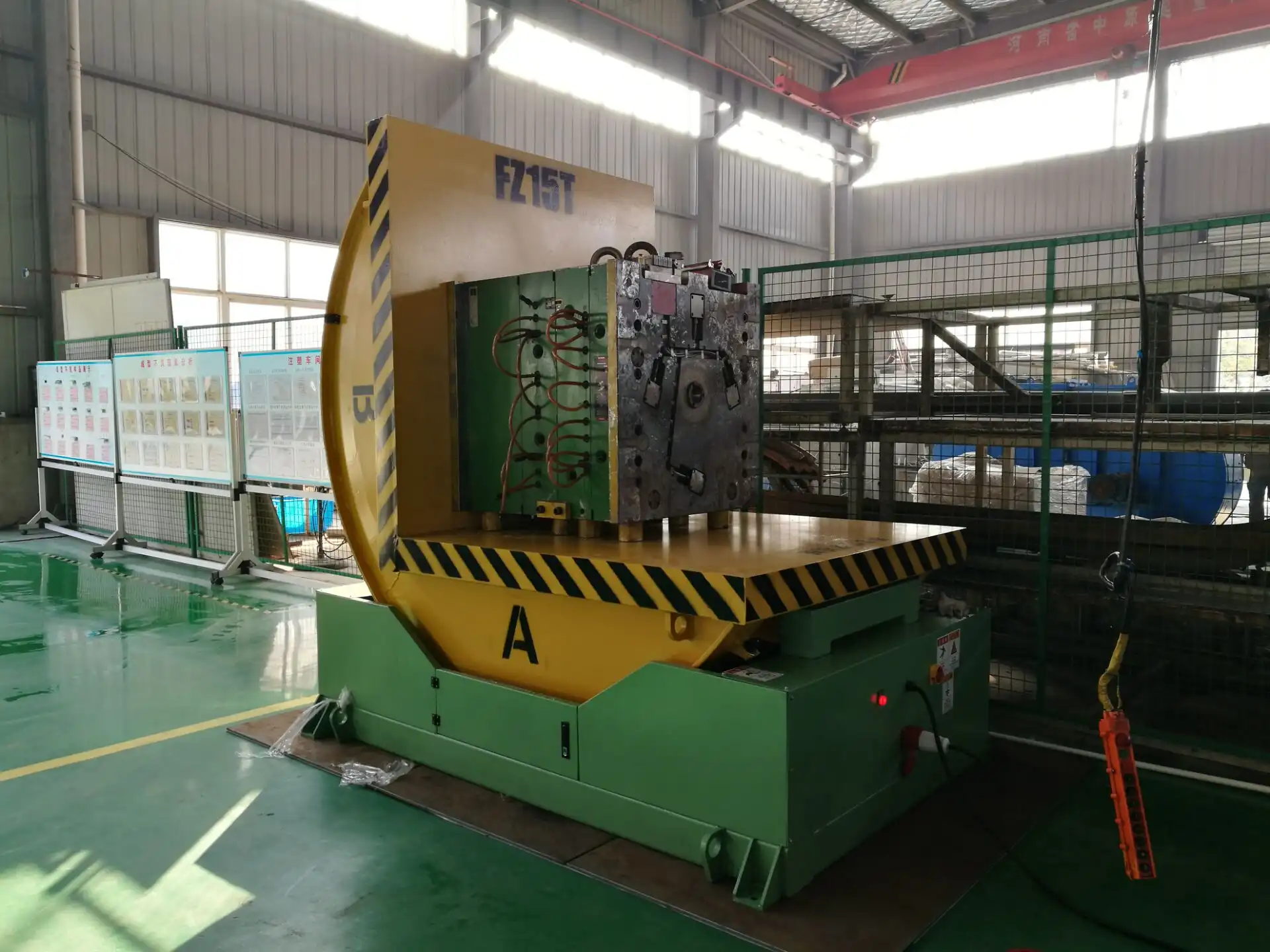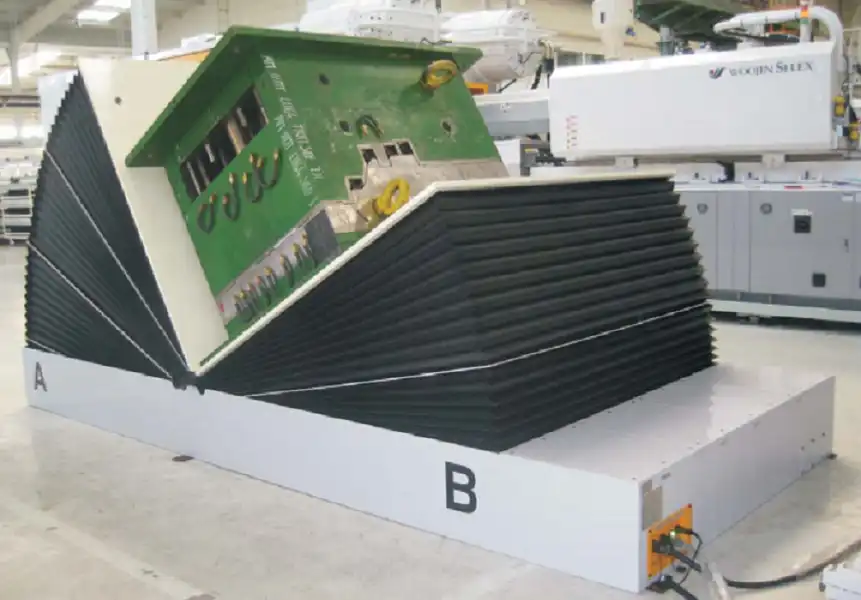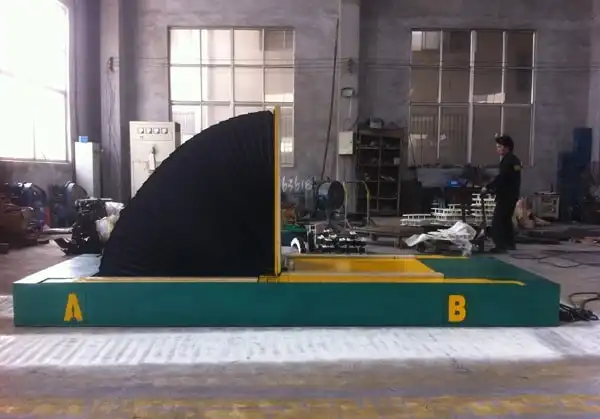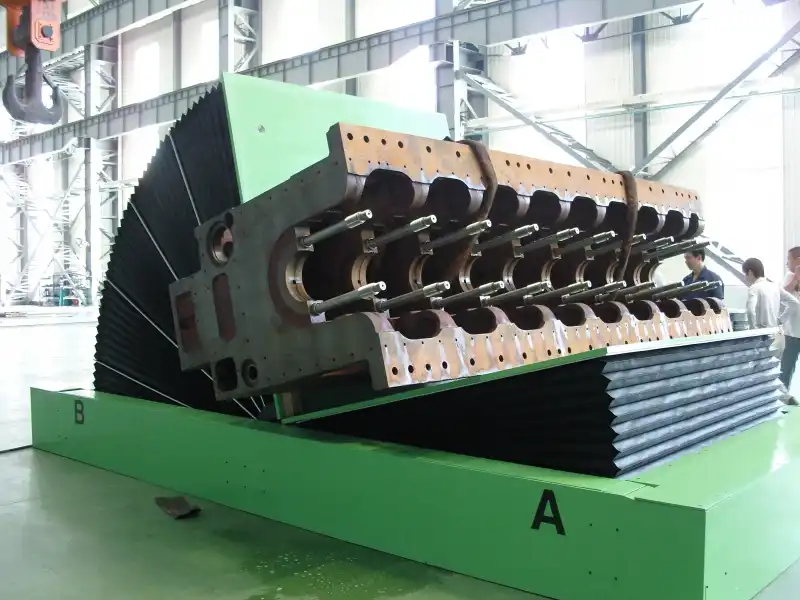Mold Flipper: Is Standardization Across Multiple Vietnam Sites Worth It?
Running a business with multiple sites, especially in a growing industrial hub like Vietnam, presents a unique set of challenges. You might have one facility in Hanoi and another in Ho Chi Minh City. Each has its own team, its own workflow, and often, its own set of equipment. This can lead to a feeling of constant firefighting. You solve a maintenance issue at one site, only to face a completely different problem with a different brand of machine at another. It's a cycle of inefficiency that quietly eats away at your profits and your team's morale. This operational chaos isn't just a minor headache; it's a strategic weakness that complicates training, inflates inventory costs, and makes consistent quality and safety an uphill battle. But there is a way to break this cycle. It involves a strategic decision to simplify and unify your operations through equipment standardization.
Yes, standardizing mold flippers across multiple Vietnam sites is absolutely worth it. The initial effort is far outweighed by the long-term benefits, which include significantly lower operational costs, streamlined maintenance and training, improved safety consistency, and a stronger strategic position for future growth and technological integration. It transforms a complex operational variable into a predictable, manageable asset.

This isn't just about making life easier for your maintenance department, though that is a major benefit. It's a high-level strategic choice that impacts your bottom line, your operational resilience, and your ability to scale effectively. For a leader overseeing multiple facilities, standardization is one of the most powerful tools for creating a lean, efficient, and predictable manufacturing ecosystem. Let's dive deeper into the specific ways this strategy pays off.
When you approve a purchase order for a new machine, the price on that paper is the most obvious cost. It's easy to compare quotes from different suppliers and pick the one that seems most economical for a specific site at that moment. But this narrow focus on the initial purchase price is a trap. It hides a web of secondary costs that emerge over the life of the equipment. Imagine your Vietnam sites: one uses a mold flipper from a German brand, another from a local supplier, and a third from an Italian company. Each requires a different set of spare parts, different maintenance knowledge, and a different supplier relationship. This patchwork approach creates a constant, low-level drain on your resources, a problem that only gets worse as your operations grow.
The hidden costs of non-standardized mold flippers are substantial and varied. They include the expense of maintaining a large and diverse spare parts inventory, the premium costs of emergency procurement for unique components, the inefficiency of managing multiple supplier contracts, and the significant financial losses from extended production downtime when the right part or skill isn't immediately available.

Let’s break these hidden costs down to see the real financial impact. When you look beyond the initial price tag, the business case for standardization becomes crystal clear. It’s a shift from short-term purchasing decisions to long-term strategic asset management.
The True Cost of Spare Parts
With non-standardized equipment, your spare parts inventory becomes a major liability. Each make and model of mold flipper requires its own set of critical components: motors, hydraulic pumps, sensors, bearings, and electrical parts. Your maintenance warehouse at each Vietnam site has to stock parts for its specific machine. This creates redundancy and bloats your overall inventory. The capital tied up in these parts is money that could be invested in growth, innovation, or other high-return areas.
Furthermore, managing this diverse inventory is a complex task. Your procurement team has to track minimum stock levels for dozens, if not hundreds, of different part numbers. It's easy for something to be overlooked. When a unique component fails and you don't have a spare, you're forced into emergency procurement. This often means paying premium prices and exorbitant air freight charges to get a production line running again. I remember a client who had three different brands of coil tilters across their facilities. A simple hydraulic valve failure at one plant shut them down for two days because the part was unique to that machine and had to be flown in from Europe. The cost of the lost production dwarfed the cost of the valve itself.
| Metric | Non-Standardized Approach | Standardized Approach |
|---|---|---|
| Required Part Types | High (e.g., 3x sets for 3 sites) | Low (1x set for all sites) |
| Inventory Capital | High (Capital tied up in redundant parts) | Low (Centralized, lean inventory) |
| Procurement Complexity | High (Multiple suppliers, contracts) | Low (Single supplier, streamlined process) |
| Risk of Stock-out | High | Low (Parts can be shared between sites) |
| Emergency Freight Costs | Frequent | Rare |
Operational Inefficiency and Downtime
The costs go beyond just parts. When a machine goes down, every minute counts. With a patchwork of different mold flippers, your maintenance team faces a steep learning curve with every repair. They can't develop a deep expertise. A technician who is a master of the machine at Site A might be a novice on the machine at Site B. This extends diagnosis and repair times, directly increasing downtime.
Standardization creates a pool of experts. A problem solved at your Hanoi facility provides a direct lesson for your team in Da Nang. This shared knowledge base is invaluable. It reduces troubleshooting time and ensures repairs are done correctly the first time. The goal for any modern plant is to increase equipment uptime. Non-standardization actively works against this by creating unnecessary complexity and slowing down the very people responsible for keeping your lines moving. The "cost" isn't just the repair itself; it's the lost production, the delayed shipments, and the potential damage to your reputation as a reliable supplier.
How does standardization impact maintenance and training?
Your maintenance team is the backbone of your production stability. Yet, in a multi-site operation with diverse equipment, they are often set up to fail. You ask them to be experts on everything, which in reality means they become masters of nothing. A technician might spend Monday learning the quirks of a European-made mold flipper and Tuesday struggling with the different control panel of an Asian model. This constant context-switching is inefficient and a recipe for mistakes. It makes scheduling maintenance, managing skills, and training new hires a logistical nightmare. The core problem is a lack of focus, forcing your team to be reactive rather than proactive.
Standardization fundamentally transforms maintenance and training from a complex, reactive burden into a streamlined, proactive system. It allows you to create a single, high-quality training program and a uniform set of maintenance procedures. This builds a more skilled, flexible, and efficient technical team that can work seamlessly across all your Vietnam sites, reducing downtime and human error.

Think of it as creating a center of excellence for your maintenance operations. Instead of spreading your resources thin across multiple platforms, you concentrate them on one. This focus allows for deep knowledge, continuous improvement, and a level of operational excellence that is simply unattainable with a non-standardized approach.
Creating a Unified Maintenance System
When all your mold flippers are the same, you can develop a single, optimized preventive maintenance (PM) program. You can create one detailed checklist, one schedule, and one set of best practices that applies to every machine. Your maintenance planners can schedule work efficiently, knowing that the tasks, tools, and parts required are identical at each Vietnam facility. This consistency is the foundation for a world-class maintenance organization.
Technicians become true experts. They learn the machine's specific failure modes and can often predict issues before they cause a breakdown. This is the first step toward a predictive maintenance strategy, a key goal for any forward-thinking industrial leader. I've seen this transformation firsthand. A steel processing client of mine standardized their packing lines. Within a year, their maintenance team went from constantly fighting fires to actively improving machine performance. They developed custom tools and procedures that were only possible because they could focus their energy on a single equipment platform. This consistency also means a technician from one site can immediately and effectively support another site during a crisis or staff shortage, creating a level of flexibility that is a huge strategic advantage.
Streamlining the Training Process
Training is another area where standardization pays huge dividends. Instead of developing and maintaining multiple training programs, you create one comprehensive curriculum. New hires can be trained more quickly and effectively, bringing them up to a high standard of competence before they even touch the machine. Your training materials—manuals, videos, hands-on exercises—are developed once and deployed everywhere. This not only saves time and money but also ensures a consistent level of knowledge across your entire workforce.
For your existing staff, standardization allows for deeper learning. Instead of constantly learning the basics of new equipment, they can advance their skills in areas like advanced troubleshooting, hydraulic system optimization, or PLC programming for that specific machine. This investment in your people leads to higher job satisfaction, lower employee turnover, and a more capable team. A well-trained operator or technician who is confident with their equipment is also a safer and more productive one. They understand the machine's limits and its capabilities, leading to fewer errors and better performance. This moves training from a simple cost center to a strategic investment in your company's human capital.
Can standardized mold flippers improve safety and efficiency?
In any heavy industrial environment, safety and efficiency are two sides of the same coin. An unsafe process is rarely an efficient one, as accidents lead to downtime, investigations, and a loss of morale. A major challenge in managing multiple sites, like your facilities in Vietnam, is enforcing a consistent safety culture. When operators move between lines or sites with different equipment, they face different control layouts, different emergency procedures, and different operational risks. This inconsistency is a direct threat to safety. At the same time, this variability slows down production, as each machine's unique process requires a different workflow and cycle time, making overall production planning difficult.
Absolutely. Standardized mold flippers directly and significantly improve both safety and efficiency. Safety is enhanced by creating uniform operating procedures and a predictable environment, which minimizes human error. Efficiency grows from streamlined workflows, reduced operator cognitive load, and the ability to establish a consistent, optimized production rhythm across all facilities.

By standardizing, you are not just buying a piece of metal; you are designing a better, safer, and more productive work process. You are removing variables that create risk and inefficiency, allowing you to focus on optimization and continuous improvement.
Establishing a Gold Standard for Safety
With a single model of mold flipper across all your Vietnam sites, you can establish one "gold standard" for safety. You design the guarding, light curtains, emergency stops, and lock-out/tag-out (LOTO) procedures once. This single, high standard is then replicated at every installation. It becomes the benchmark for all operations. This makes safety training incredibly straightforward. An operator trained at one facility knows the exact safety protocol for the machine at any other facility.
This uniformity makes safety audits far more effective. Your safety managers can use a single checklist to evaluate compliance across the board. They can easily identify deviations and implement corrective actions that apply to the entire fleet of machines. I started my career on the factory floor, and I learned early on that complexity is the enemy of safety. When a process is simple, repeatable, and predictable, people are less likely to make mistakes or take shortcuts. Standardization is the most effective way to engineer that simplicity into your operations, creating an environment where the safest way to do the job is also the easiest and most obvious way.
Boosting Operational Efficiency
From an efficiency standpoint, standardization is a powerful enabler of lean manufacturing principles. It eliminates the waste associated with process variation. When every mold flipper operates identically, you can fine-tune your workflow for maximum throughput. You can establish a standard cycle time that becomes a reliable input for your production scheduling platform. This helps in achieving the kind of smart scheduling and high capacity utilization that modern steel plants strive for.
Furthermore, it reduces the cognitive load on your operators. They don't have to mentally switch gears when moving from one machine to another. Their actions become second nature, leading to faster and more consistent performance. This muscle memory is key to achieving high levels of efficiency and quality. You can measure and compare the performance of different shifts or even different sites using true apples-to-apples data, because the equipment variable has been removed. This allows you to identify the most effective teams and turn their practices into the standard for everyone, driving a cycle of continuous improvement across your entire organization.
| Aspect | Non-Standardized Environment | Standardized Environment |
|---|---|---|
| Operator Training | Complex; multiple machine types | Simple; one machine, one process |
| Safety Procedures | Varied and inconsistent | Uniform and easy to enforce |
| Cycle Time | Unpredictable; varies by machine | Predictable and optimized |
| Workflow Design | Compromised to fit multiple machines | Streamlined around one process |
| Data for Analysis | Inconsistent ("apples to oranges") | Consistent ("apples to apples") |
What are the long-term strategic benefits of standardization?
As a business owner, your decisions go beyond the immediate operational concerns. You have to think about the long-term health and strategic positioning of your company. Choosing equipment isn't just a technical decision; it's a strategic one that will have consequences for years to come. A reactive, piecemeal approach to purchasing—buying whatever seems best for one site at one time—creates a complex and rigid operational structure. This approach makes you vulnerable to supply chain disruptions and hinders your ability to adapt to new technologies or market opportunities. It's a short-term tactic that undermines long-term strategy.
The long-term strategic benefits of standardization are profound. They include building stronger leverage with a key supplier to create a true partnership, future-proofing your operations for easier scalability and technology integration, and enabling powerful data analytics by providing clean, consistent operational data across all your Vietnam sites.

This is about moving from simply buying machines to building a strategic manufacturing platform. It’s a foundational decision that gives you more control, more flexibility, and a significant competitive advantage in the long run.
From Supplier to Strategic Partner
When you purchase one or two machines at a time from various suppliers, your relationships are purely transactional. You are just another customer. However, when you decide to standardize and commit to a single supplier for all your mold flipper needs across multiple sites, the dynamic changes completely. You are no longer just buying a product; you are making a significant investment in their technology. This gives you leverage.
This leverage allows you to negotiate more than just price. You can negotiate better terms for service, spare parts availability, and dedicated technical support. You can work with them to make custom modifications that perfectly suit your specific operational needs. The supplier now sees you as a strategic partner, not a one-off sale. They have a vested interest in your success because your growth means more business for them. At SHJLPACK, these are the relationships we seek to build. We want to be more than a vendor; we want to be a part of our client's long-term success story, providing insights and support that go far beyond the initial sale. This partnership is a powerful asset that is impossible to achieve when you spread your purchases across multiple suppliers.
Future-Proofing for Growth and Technology
Standardization makes your business more agile and ready for the future. Imagine you decide to open a new facility in Vietnam or expand an existing one. The equipment decision is already made. You can essentially "copy and paste" your proven, optimized setup, which dramatically reduces the time, risk, and cost of expansion. You already have the training programs, maintenance schedules, and spare parts strategy in place. This ability to scale quickly and predictably is a massive competitive advantage.
Furthermore, standardization simplifies the adoption of new technologies. For a leader focused on digital transformation, this is critical. Deploying IoT sensors to monitor machine health for predictive maintenance is far simpler across a uniform fleet of machines. Integrating the equipment with a central Manufacturing Execution System (MES) is streamlined because the data protocols are identical. Trying to do this with five different brands of mold flippers, each with its own proprietary software, is a complex and expensive integration nightmare. Standardization provides a clean, consistent platform on which you can build your digital factory of the future.
My Insight
When I first started in this industry, working on the factory floor, the idea of standardization seemed like a luxury. The focus was always on the immediate need: "We need a machine to do this job, and this one has the best price." Later, when I established my own factory, I carried some of that thinking with me. In the early days, I bought machines from different suppliers based on individual deals. The result was what I call a "Frankenstein factory"—a collection of different parts that were stitched together. It worked, but it was inefficient. My maintenance team was constantly scrambling for different parts, and training new people was a challenge.
I quickly learned a lesson that has stayed with me ever since: the initial purchase price is only a small fraction of the total cost of ownership. The real cost lies in the complexity you create. It's in the extra inventory, the longer downtimes, the complicated training, and the mental energy your team wastes managing a chaotic system instead of improving it.
For a leader like Javier Morales, who is managing a massive 2-million-ton steel operation, this principle is magnified a thousand times. He's not just managing machines; he's managing a complex ecosystem of people, processes, and technology. His challenges—volatile energy costs, aging equipment, and market fluctuations—all demand a single response: simplification and control. Standardization is the most powerful tool to achieve this.
Choosing to standardize mold flippers across his Vietnam sites is not just an equipment decision. It is a strategic leadership decision. It’s about intentionally reducing operational complexity so you can focus on the big picture: lowering costs, driving efficiency, and ensuring the long-term health of the business. It directly supports his goals of increasing equipment uptime to 95% and lowering operating costs by 8%. You can't achieve that level of performance when your foundation is a patchwork of different technologies.
The path to building a successful, efficient, and scalable manufacturing operation—the very path that allowed me to achieve my own success—is paved with smart, strategic decisions that favor long-term simplicity over short-term variety. Standardization is one of those cornerstone decisions.
Conclusion
Standardization is more than an operational tactic; it's a winning strategy. It simplifies processes, slashes long-term costs, and builds a resilient, scalable foundation for your multi-site manufacturing future.





